Release a brain dump in your sketchbook with ideas like mind maps, wild word lists, and doodle clusters that look like creatures from your dreams (or nightmares). Mix up magazine clippings for collages, toss in some “what if” pages for funny daydreams, or scribble down art quotes that sound way wiser than you feel. Try mood boards, themed brainstorms, or messy freeform sketches—no perfection needed. If you want the full creative chaos toolbox, there’s more waiting just ahead.
Key Takeaways
- Try mind mapping and concept webs to visually organize and connect your scattered ideas.
- Use freeform sketch dump sessions or doodle clusters to quickly capture spontaneous thoughts without worrying about perfection.
- Create word lists or stream-of-consciousness journal pages to rapidly unload mental clutter and inspire new ideas.
- Experiment with mixed media collage pages and visual mood boards to express complex emotions and spark creative exploration.
- Collect inspiring art quotes and add personal reflections or themed pages to both motivate and personalize your sketchbook experience.
Mind Mapping for Visualizing Connections
Creativity buzzes to life when mind mapping enters the scene. Imagine a blank page, and suddenly, ideas explode out like fireworks, each one connecting to another in a colorful web.
Mind mapping is more than just doodling circles and lines—it’s a visual brainstorming superpower. Each node holds a key idea, and then branches off into new and surprising directions. Add some neon highlights, silly sketches, or bold images, and boom! Memory gets a major power-up, and even boring topics become way easier to understand.
Whether someone uses cool apps or just grabs their favorite markers, mind mapping helps them reveal tricky ideas. By visiting and updating their mind map, they spot new connections, making their thoughts sharper and their creativity unstoppable.
Freeform Sketch Dump Sessions

Freeform sketch dump sessions are all about letting your pencil wander—no rules, no stress, just marks on the page wherever your imagination takes you.
This is the best time to catch those random flashes of ideas before they disappear, and nobody’s there to judge if your drawing looks a little weird or unfinished.
Forget perfection; the messier it is, the more fun you’ll have, and who knows—your happiest accident might become your next favorite creation!
Embracing Spontaneous Mark-Making
Sometimes, there’s just nothing better than grabbing a pencil (or a weird marker you found at the bottom of your backpack) and letting your hand go totally wild on the page. Freeform sketch dump sessions make for an epic brain dump, letting every random thought tumble out as doodles, squiggles, or wild lines. No one’s judging; it’s just you and your sketchbook getting creative without any rules. Pushing yourself to finish something in just 5 or 10 minutes? That’s where the magic—and the mess—happens. Throw in different tools for surprise textures and wild effects. This unpredictability makes creativity way more fun and fearless.
| Tool/Medium | Texture Created | Feeling Sparked |
|---|---|---|
| Graphite Pencil | Soft shading | Calm, focused |
| Ballpoint Pen | Crisp, sketchy | Adventurous |
| Marker | Bold, streaky | Wild, energetic |
| Crayon | Waxy, layered | Playful, nostalgic |
| Chalk Pastel | Dusty, dreamy | Relaxed, open-minded |
Capturing Fleeting Visual Ideas
Even when it feels like ideas slip away faster than ice cream melts in the sun, a quick sketch dump session can catch them before they disappear.
In these freeform sketch dump sessions, there’s no need to overthink—just let your pencil or pen wander across the page, grabbing any odd shape, cool face, or strange doodle that pops into your mind.
Some artists set a timer and draw whatever they see or feel, while others just let inspiration flow without rules until their page buzzes with energy.
Mixing up mediums, like colored pencils or markers, can spark even more weird—and wonderful—creations.
Keeping everything in one sketchbook means you’ve got a treasure chest of ideas ready whenever you need a creative boost.
Letting Go of Perfection
Let’s be honest—perfection is overrated, and in the world of sketchbook dumps, it’s pretty much the enemy of fun.
Freeform sketch dump sessions are all about letting your brain run wild on the page without worrying about every little mistake. It doesn’t matter if a line is wobbly or if your cat looks more like a squirrel—this is about the process, not the end masterpiece.
Setting a timer adds excitement, pushing your brain to move faster and worry less. Mixing up materials keeps things extra interesting, and you never know what happy accidents might happen.
Over time, doodling boldly like this can shake loose creative blockages, build confidence, and help your brain develop a totally original artistic style—no perfection required.
Word Lists for Rapid Idea Generation
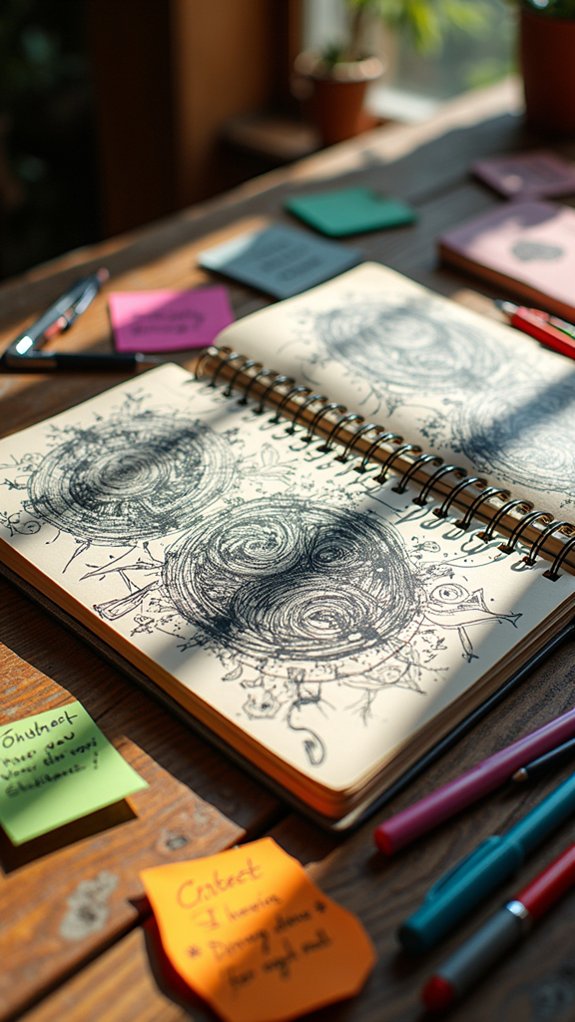
Speedy word brainstorm sessions can turn a blank page into a wild storm of ideas, making it almost impossible to run out of things to draw or write about.
Picking themes for these word lists, like “space adventures” or “mystical forests,” gives the whole mess some direction, so the ideas don’t end up as random as socks in the laundry.
Once the words are flying, it helps to organize them into clusters or categories, so you can actually find the sparkly gems later instead of a jumbled pile of “cloud whale” and “pizza crown.”
Speedy Word Brainstorm Sessions
Brainstorming sessions—where imaginations run wild and pencils fly across the page—might just be one of the fastest ways to blast through a creative block.
Speedy word brainstorm sessions work like a supercharged version of Brain Dumping. You grab a timer, set it for five or ten minutes, and try to toss down as many words or ideas as you can about a topic before the buzzer rings. No erasing, no judging, just pure, delightful chaos on the page!
Here’s what makes this technique shine:
- Timed sprints break overthinking and encourage quick thinking.
- Visual tools, like mind maps, help spot surprising ideas.
- Spontaneity sparks creativity and fresh connections.
- The sheer volume of ideas can boost confidence.
- Regular practice can zap brain fog and keep creativity flowing.
Themes for Word Lists
Word lists are like secret treasure maps for artists who get stuck wondering what to draw next. When ideas run dry, creating lists from themes—like emotions, colors, nature, or even weird everyday objects—gives you tons of fresh starting points.
Set a five-minute timer and let your mind zoom from “sparkly” to “rainstorm” to “pizza planet.” Don’t worry about making sense; just get those words out!
Try focusing on certain categories, like wild verbs, odd adjectives, or random nouns. That way, you can mix and match ideas for even crazier drawing prompts. Imagine sketching a “dancing pencil” or a “sleepy thundercloud.”
The more often you add to your list of themes, the bigger your universe of sketchbook ideas becomes.
Organizing Generated Word Ideas
Once a mountain of zany, cool, or downright odd word ideas starts piling up, it can get messy fast—like digging for your favorite marker in a bottomless pencil pouch.
That’s why organizing generated word ideas into easy-to-read lists makes a huge difference. Word lists help untangle the chaos, making rapid idea generation way easier and way less dramatic.
Throw in some fun themes like “spooky places” or “epic emotions,” and suddenly it’s like you have a cheat code for creativity.
Don’t forget—keeping things neat helps you actually find your best ideas later!
Check out these tips:
- Categorize by themes for easy access
- Use notebooks or digital apps for flexibility
- Add quick doodles alongside words
- Review and update your lists often
- Create mind maps to spark new links
Stream-of-Consciousness Journaling
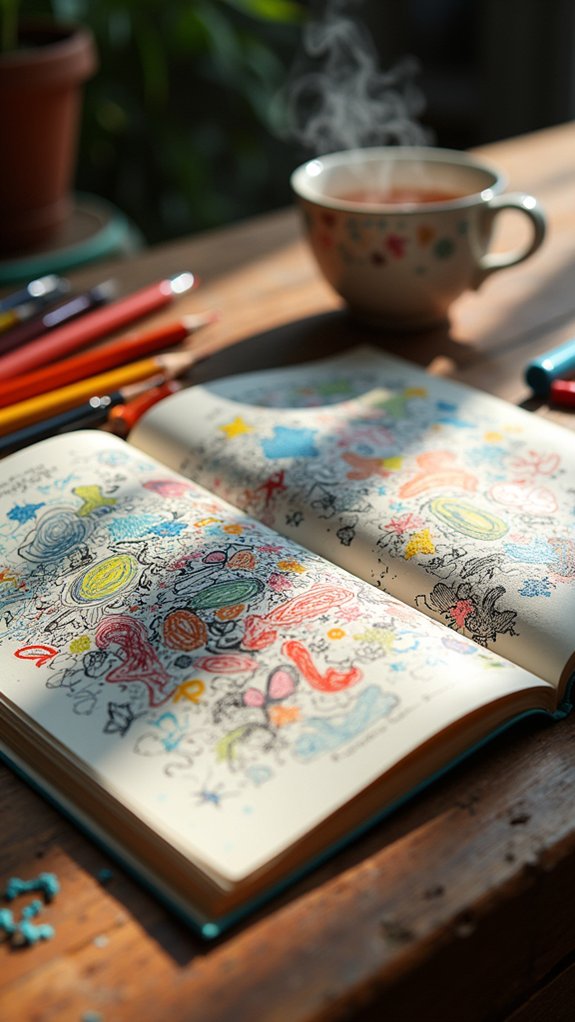
Even if someone has never tried it before, stream-of-consciousness journaling can feel a bit like letting your brain throw its own surprise party—no guest list, no decorations, just pure, unfiltered thoughts spilling onto the page.
There’s no worrying about grammar or if things sound “right”; instead, every idea, no matter how weird or random, gets a chance to shine. This method lets people push past that annoying little inner critic and actually discover what’s swirling around in their heads.
Stream-of-consciousness journaling is super helpful for creativity, kind of like giving imagination a green light. Plus, it’s huge for mental health—jotting down raw emotions can seriously lower stress.
It’s simple, sometimes messy, but always worth it for anyone wanting to clear mental clutter.
Collage Pages for Mixed Media Exploration
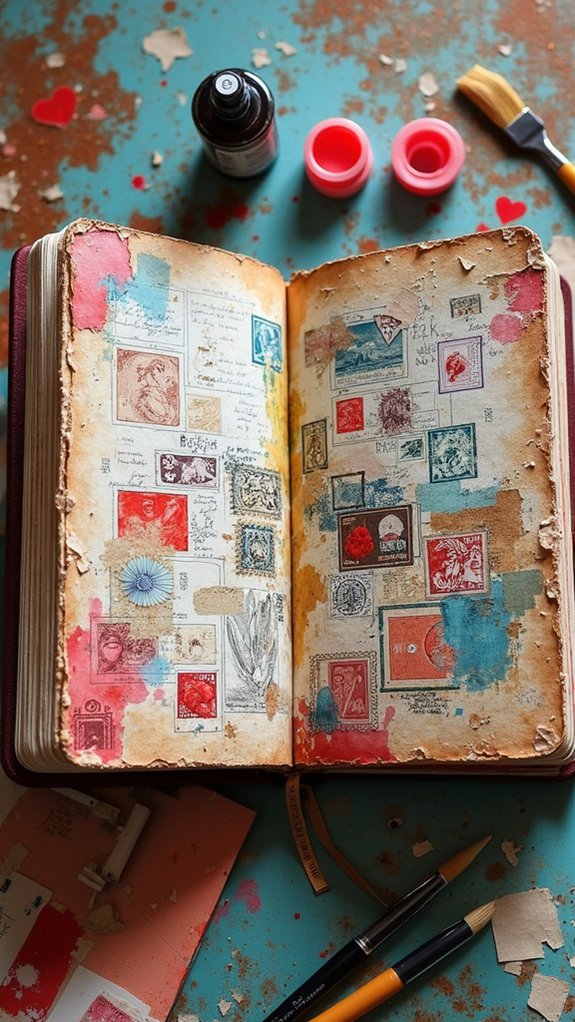
Dive headfirst into the world of collage, and suddenly a sketchbook feels less like plain paper and more like a playground for wild ideas.
Collage pages are a way to create wild art using magazine clippings, old photographs, weird textured papers, and whatever else you can glue down without getting your fingers too stuck together.
Mixed media isn’t just about slapping things together; it’s about layering, telling stories, and experimenting with how different stuff can come together on a single page.
Check out these awesome ways to make your collage pages pop:
- Try funky adhesives like mod podge or double-sided tape for staying power
- Mix in handwritten notes for a personal vibe
- Coordinate themes or colors to build cool stories
- Layer paint splashes for extra flair
- Practice arranging, cutting, and pasting for better composition skills
Doodle Clusters for Spontaneous Creativity
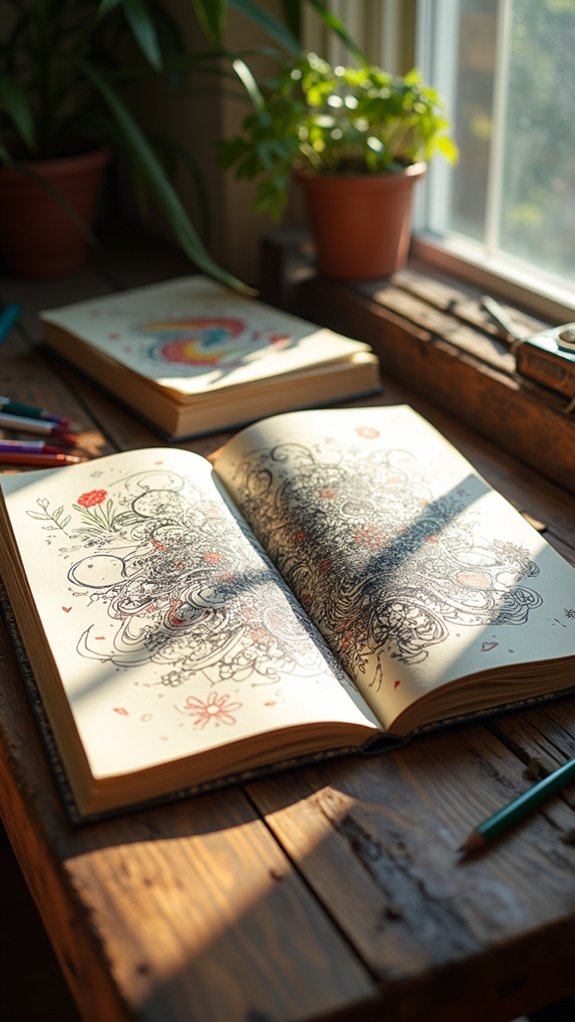
Grab a pen and let the ideas spill—doodle clusters are all about letting creativity run wild without worrying if things are perfect or polished.
Imagine drawing a mini galaxy of silly monsters, clouds, or random symbols hugging each other on a single page. Doodle clusters let artists dump their thoughts in little bursts, making it almost impossible to get stuck or bored.
The best part? There are no rules about neatness—mistakes can turn into unexpected masterpieces. Mixing a bunch of related images close together clears out mental clutter and gets those fun brainstorming sparks flying.
Artists often use doodle clusters to warm up, stretching the imagination before serious drawing takes over. Sometimes, the weirdest combinations surprise everyone—and spark cool new ideas they never saw coming!
Concept Webs for Expanding Single Ideas
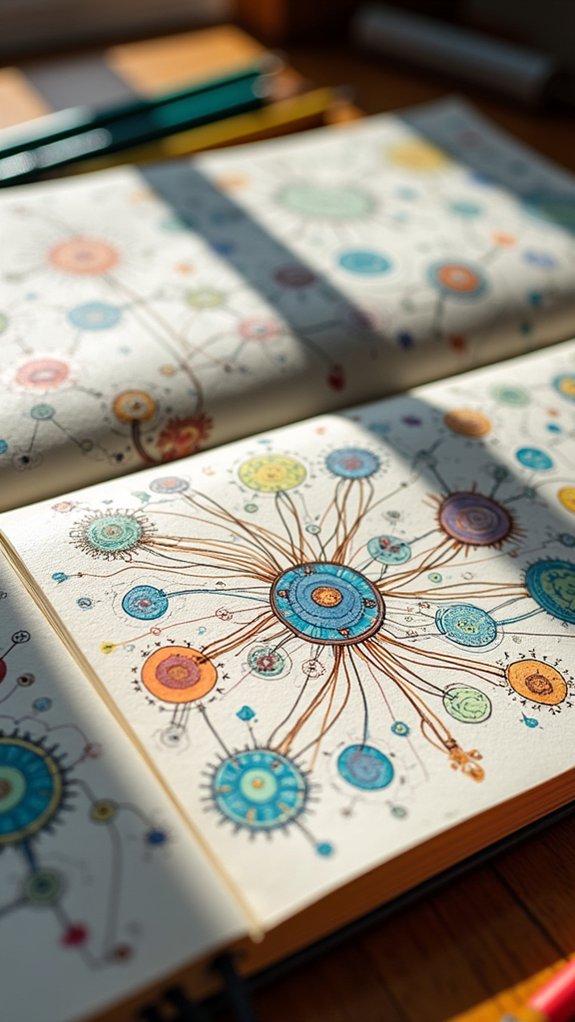
Once the page is covered with a wild tangle of doodles, some artists might want to chase a single cool idea a bit further. That’s when concept webs come in handy—they’re like a brain map for one awesome idea!
A concept web starts with the main thought right in the middle, then branches out with lines and shapes to show all the different directions that idea could go. It’s like the ultimate “choose your own adventure” brainstorm!
Check out what makes concept webs so useful:
- Branches reveal new angles and details about your main idea
- Using colors or funky shapes keeps everything organized
- You can build webs with paper, markers, or digital tools
- Revisiting webs often reveals unexpected connections
- They’re great for unleashing next-level creative energy
Themed Brainstorming Pages
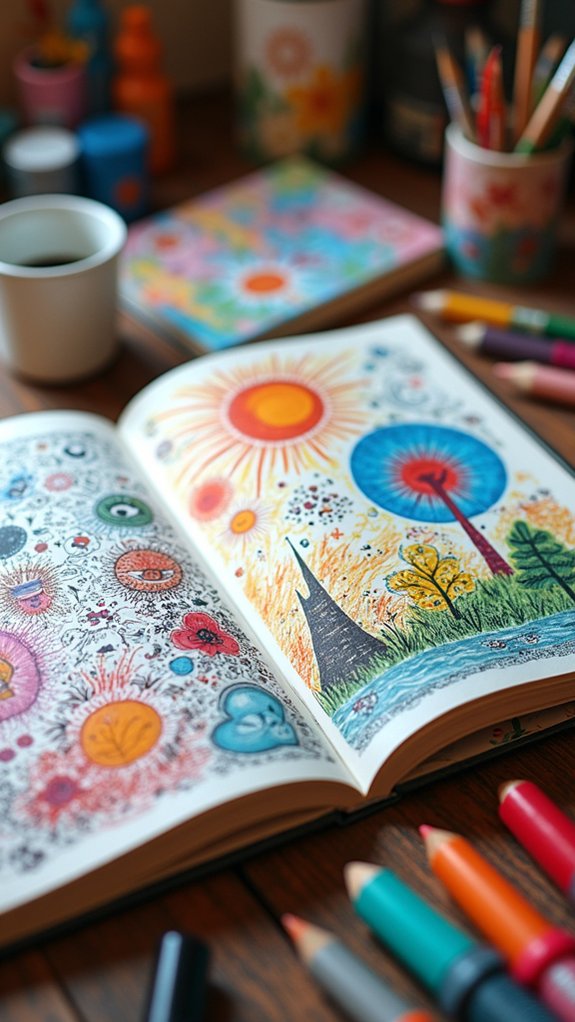
Every sketchbook artist knows the real excitement can hit when a blank page gets a very specific purpose. That’s exactly where themed brainstorming pages come in—they’re like giving your brain a VIP pass to explore one awesome topic at a time.
Instead of random doodles, try picking a theme, like nature, emotions, or your wildest summer memory. Use mood boards, sketch little object clusters, and splash some color palettes everywhere. It makes the ideas pop and helps you find new connections.
Plus, themed brainstorming pages are perfect for stress relief—there’s something about focusing your thoughts that quiets all the chaos. Revisit these pages later, and you might spot an idea you missed or feel inspired to take it somewhere totally new!
Bulleted Task and Thought Lists
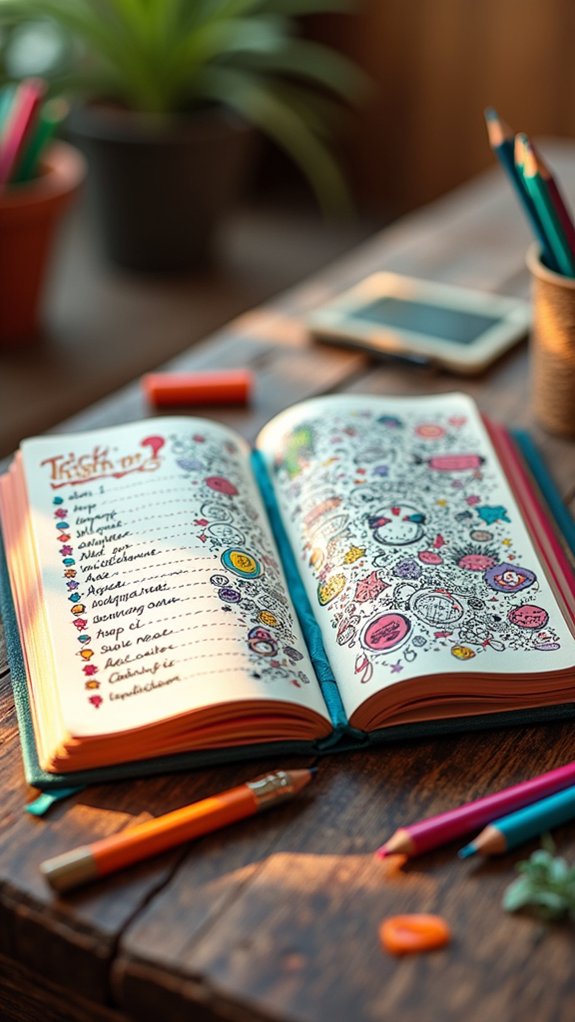
Although sketchbooks are usually bursting with wild drawings and splashy colors, sometimes the best ideas sneak in as speedy little bullet points. Bulleted task and thought lists let creativity take a quick breather—they’re like a brain dump for all those wild ideas refusing to sit still.
Here’s the best part: nobody has to write in fancy sentences or follow grammar rules (freedom!). These lists work hard behind the scenes, turning that messy swirl in someone’s mind into cool, organized action. They make stuff easy to spot, easy to remember, and way less stressful.
Try making a space for them, and thank yourself later.
- Fast jotting without fuss
- Simplifies priorities and sorting
- Boosts memory through visual structure
- Sparks regular review habits
- Helps declutter mental overload
Storyboarding With Sequential Sketches
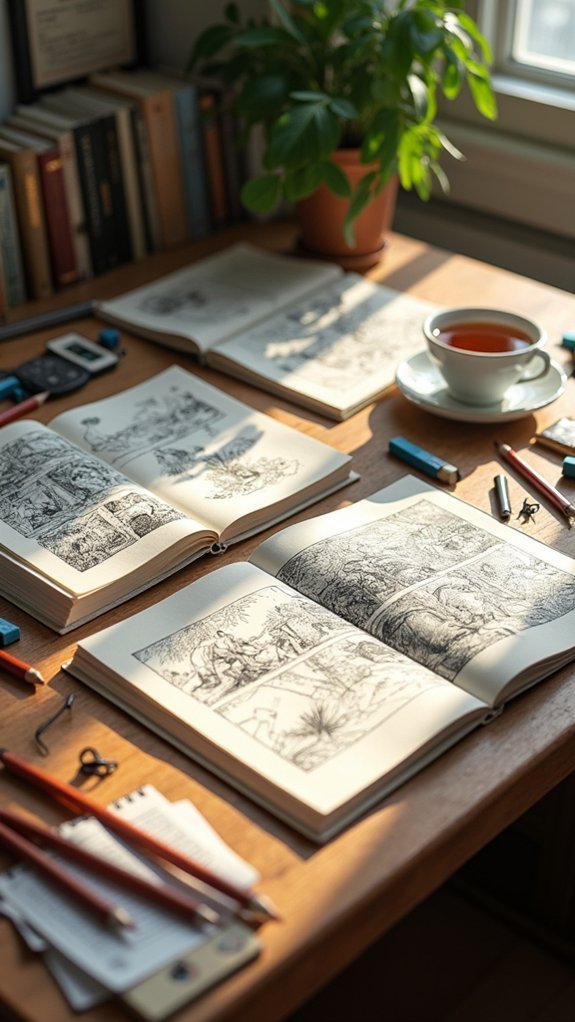
Storyboarding with sequential sketches is like creating a comic strip that lets you watch your story come to life, step by step.
It helps you spot how things flow—does your hero run into trouble too fast, or do they need a moment to catch their breath—and gives each character a chance to shine on their own page.
With a little humor and some quick drawings, anyone can start to see how the plot twists, the action builds, or the awkward-funny moments all fit together; it’s storytelling you can actually see.
Visualizing Narrative Flow
Ever wonder how your favorite movies or comics go from wild ideas to scenes that just flow together perfectly? That’s the magic of visualizing narrative flow—using sequential sketches, also called storyboarding, to Clear Your Mind and organize chaos into a storyline that actually makes sense.
When artists storyboard, they turn messy thoughts into a series of small pictures, each showing what happens next. This helps break a story down into bite-sized chunks, keeping everything smooth and easy to follow.
Check out what makes this process so awesome:
- Lets you spot and fix confusing scenes before you commit
- Helps balance action, dialogue, and quiet moments
- Keeps pacing on track, so stories don’t drag or rush
- Makes connections between scenes crystal clear
- Creates a guide for anyone helping with your story
Character Development Pages
A lot of artists know the struggle—one minute, a character leaps off the page, bursting with personality, and the next they’re as flat as stale soda. Character development pages can be a lifesaver here.
By storyboarding with sequential sketches, artists get to watch their characters grow, change, and react throughout a story. These pages aren’t just about drawing pretty faces; they show a character’s evolution, using different poses, wild expressions, and style tweaks to highlight emotions and changes.
Adding notes and quick backgrounds turns simple sketches into a character’s personal diary—juicy secrets included! Color palettes and design notes keep the look on point, so nothing gets lost.
In the end, these pages bring characters to life and make the story pop.
Visual Mood Boards
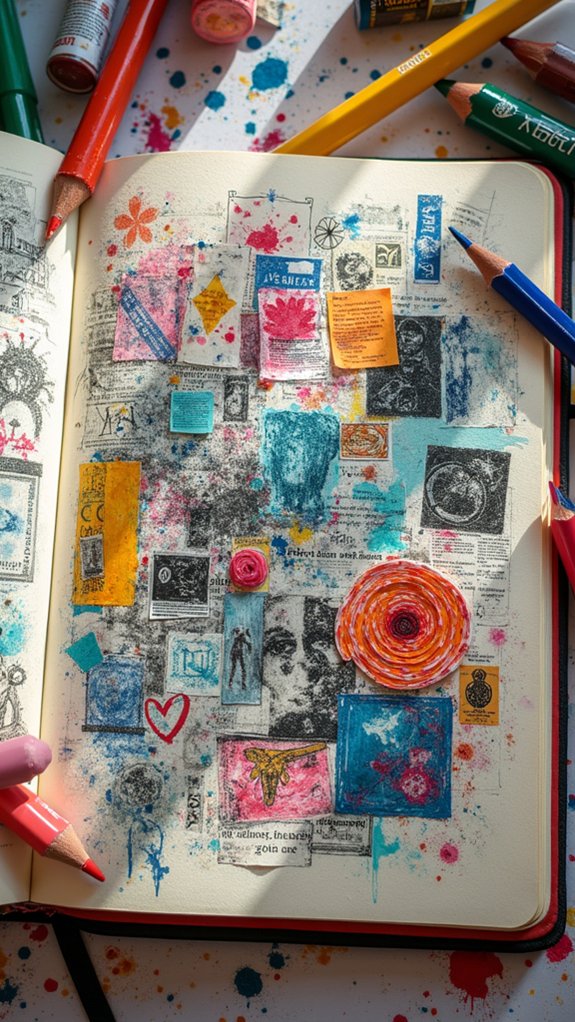
When inspiration feels a little slippery, visual mood boards swoop in like creative superheroes. These colorful collages mix images, colors, textures, and even words to express a theme, idea, or emotion.
Artists and designers love making visual mood boards because they bring fuzzy ideas into focus and add some much-needed clarity. Plus, the process is just plain fun—you get to play around with magazine clippings or digital images, letting your imagination run wild.
Want to make your own? Try these steps:
- Gather magazine pictures, fabric scraps, doodles, or printouts
- Layer images for cool new combinations and eye candy effects
- Pick vibrant colors and fun textures to set a mood
- Mix sources—nature, architecture, and fashion all work!
- Keep updating to spark new ideas and keep motivation high
What If?” Pages for Exploring Hypotheticals
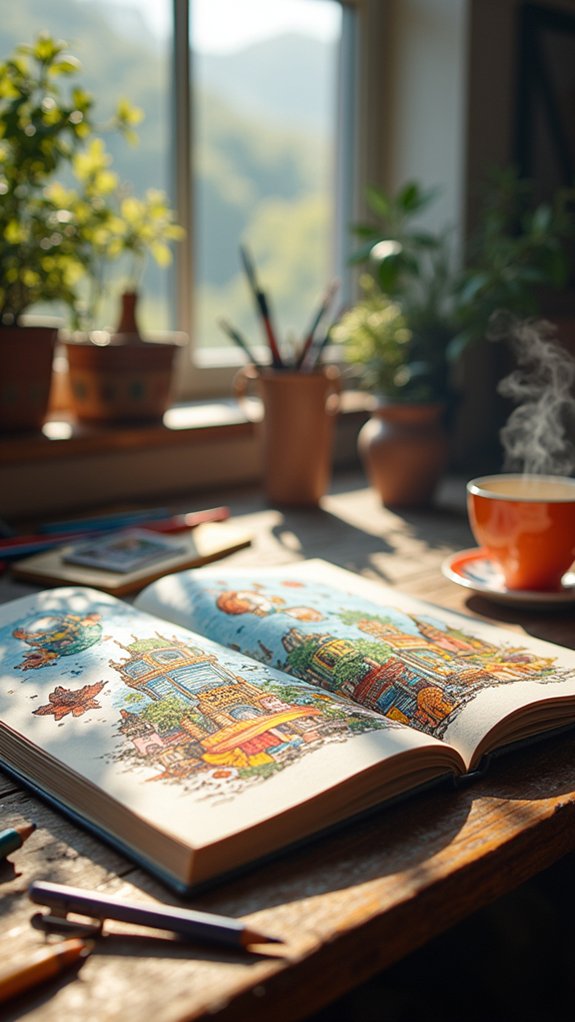
If things in art—or life—are starting to feel a little predictable, “What If?” pages in a sketchbook can totally flip the script.
It’s like asking, “What if cats ruled the world? What if humans could fly but only if they wore giant bunny ears?” These wild questions break boring routines, letting imaginations run loose.
With each what if? scenario, someone pushes past reality’s rules, exploring wild stories, odd inventions, or even silly problem solutions. Adding sketches and doodles next to a what if? idea makes things even cooler, helping the brain see stuff in brand new ways.
Besides being just plain fun, these “What If?” pages become a mini treasure chest, stuffed with creative gems ready to inspire future masterpieces or unexpected adventures.
Art Quote and Inspiration Collections
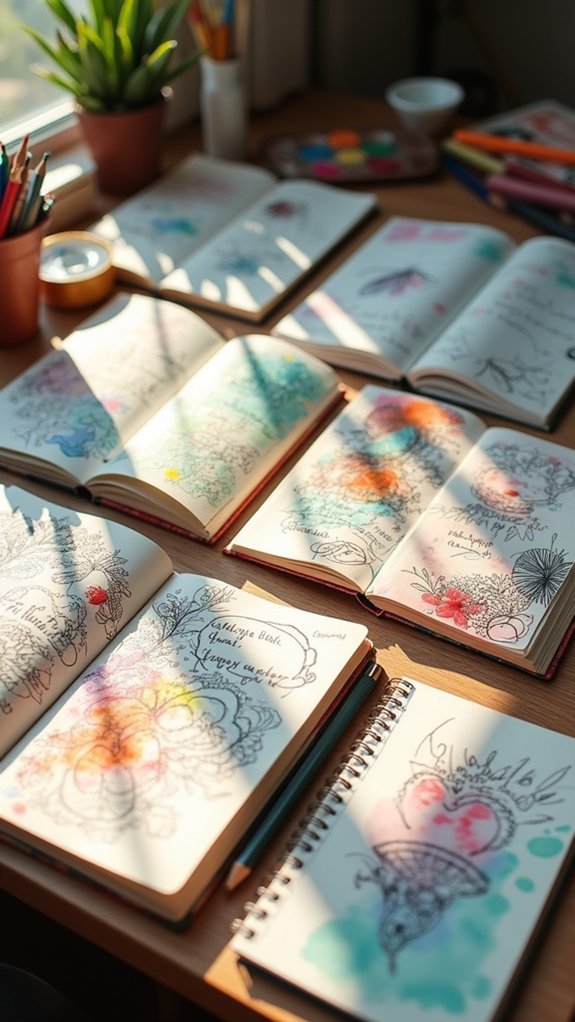
Crazy “What If?” questions can send your mind spinning into wild, new places, but sometimes the right words from artists can hit just as hard. Jotting down a killer art quote in your sketchbook isn’t just about decoration—it’s like tucking a flash of genius between your pages.
Inspiration collections packed with quotes can push your creativity when you feel stuck or just need a reason to doodle.
- Gather a bunch of quotes from different artists to build your own daily motivation.
- Make themed pages, like “Impressionist Vibes” or “Surrealist Sparks,” inspired by art movements.
- Add your own thoughts or sketches next to each quote to make it personal.
- Mix in your reactions—did a quote make you laugh? Or roll your eyes?
- Share your favorite art quote and pages with friends for even more inspiration!
Frequently Asked Questions
How Do You Do a Thought Dump?
To do a thought dump, an individual sets a timer and writes continuously, capturing every idea. Incorporating mind mapping can help visualize connections. Reviewing the notes afterwards assists in identifying recurring themes, actionable tasks, or sources of stress.
What Is a Brain Dump of Ideas?
A brain dump of ideas involves offloading all thoughts, concepts, or concerns onto paper or digital tools. This process enables creative clarity by organizing mental clutter, promoting heightened self-awareness, and fostering an environment conducive to innovative problem-solving.
What to Fill up a Sketchbook With?
When considering what to fill up a sketchbook with, one should seek creative inspiration from daily observations, artistic techniques, travel memories, abstract ideas, and collaborative projects, allowing the sketchbook to become a diverse and evolving artistic record.
How to Make Your Sketchbook Unique?
To make a sketchbook unique, one can employ creative techniques such as mixing mediums, personalizing the cover, using varied paper types, and adding handwritten notes. Organizing themed sections further showcases individuality and artistic progression within the sketchbook.
Conclusion
Sketchbook dumps aren’t just about filling pages—they’re like giving your brain a room to stretch, mess up, and get creative. Whether someone tries wild mind maps, goofy doodles, or just words tumbling across the paper, each idea helps reveal new inspiration. So why not let things get weird? It’s all about experimenting, skipping perfection, and having fun. After all, the wildest pages today might just spark the best ideas tomorrow. Grab that sketchbook and go for it!


Leave a Reply